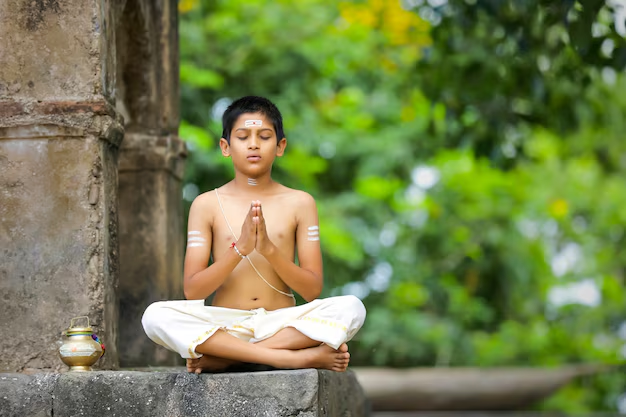Meditation is an effective way to combat anxiety, available not only to adults but also to children. The meditative process helps the child recognize emotions, cope with stress, and concentrate. As a result, learning and observation skills increase, the ability to control one’s body and emotional background develops, and the positive attitude inherent in children is preserved. So, see below the best meditation for children in India.
Table of Contents
At what age can children start meditating?
Experts do not have a consensus regarding the optimal age for practice. It is important that the child understands what he is doing and why, can control his breathing, record his feelings, and, most importantly, sincerely want to meditate. As a rule, children 5-6 years old are quite capable of performing simple practices.
Benefits Of Meditation for Children in India:
Thanks to meditation, children begin to feel better about their bodies, learn observation, concentration, and the ability to calm down and manage their emotions. Meditation involves analyzing the thoughts and feelings that a person has at the time of practice.
Children can better understand the world, and their thoughts and be aware of what is happening around them. They become more attentive to details and can concentrate faster. This is a great skill to learn in school.
Calm Children:
Even if a child has not yet developed the ability to analyze his feelings in detail, this does not mean that the simplest relaxation practices will be ineffective. Place your hand on your stomach and ask your child to do the same. Inhale and exhale slowly, noticing the sensations.
Ask your child to fully focus on the hand and the movements of the diaphragm. As a rule, the duration of the exercise for children 5-6 years old does not exceed 5 minutes. In addition to breathing, you can focus on the pulse, but children often have difficulty tracking their heartbeat.
Meditation has been scientifically proven to minimize anxiety by inhibiting the production of the stress hormone cortisol and also supports the functioning of the immune system through the synthesis of immunoglobulin A.
Increase Concentration:
Ask your child to pick up an object that pleases him, for example, a favorite toy, and describe his feelings.
Perhaps he will describe the material, shape, and size of the item, as well as the memories associated with the stuffed friend, or even come up with a story about his adventures.
The main thing is that the child is not distracted by external events and constantly concentrates on the object in his hands and the feelings associated with it.
Practice to Maintain a Positive Attitude:
The following exercise will help children improve their mood, express positive emotions towards others, and cope with negativity. Practice can be accompanied by music that is pleasant for the child.
Ask them to close their eyes and imagine themselves surrounded by friends or family. Also, the child can visualize any person he likes, even if they are characters from fairy tales or cartoons.
Next, ask your child to imagine that he is giving gifts to others, for example, in the form of flowers, toys, drawings, or decorated boxes. Let the child independently come up with what gifts he wants to give, and then describe his state and the emotions that he experienced while sharing his joy.
Meditation for Healthy Sleep:
Meditation helps you feel relaxed and move on to full, healthy sleep, gradually reducing the level of emotions and anxiety.
Practicing a sense of space will help you calm down before going to bed. Ask your child to close his eyes and focus on the sounds around him, without thinking about anything extraneous, to feel the atmosphere of home and, accordingly, comfort and safety.
Reduce Anxiety:
To get rid of anxiety, it is recommended to remember pleasant events, immerse yourself in them. Smiling is the best and easiest meditation before bed. Practices in the format of fairy tales are also suitable for children when the child feels like a part of a good fantasy plot and can imagine himself as a full-fledged hero or even a co-author of the story.
Meditation for Children in India:
Meditation has recently become a popular practice, recommended for improving concentration, combating stress, and general relaxation. At first glance, the rules and methods of this technique are quite complex: you need to be able to concentrate, listen to your inner voice, and control your body. So, see below the best meditation for children in India.
Breathing Meditation:
The simplest, but no less effective meditation technique. It teaches you how to breathe correctly, and consciously relax, calm you down, and make you feel better immediately after meditation.
This practice does not last long, about five minutes. You can choose the time yourself – depending on how much you consider necessary. Sit on the floor in the lotus position and straighten your back – the entire meditation should be done with a straight but relaxed back. Start the timer, close your eyes, and just start breathing.
Breathe slowly. Inhale smoothly through the nose. Exhale – a little faster, through the mouth. After exhaling, you can hold your breath for a short time.
Gratitude Meditation:
Gratitude meditation gives support when it seems that everything is falling out of hand and nothing good has happened during the day. In practice, it is important to focus on what you were grateful for during the day: yourself, those around you, and even circumstances that are beyond your control.
This technique doesn’t necessarily force you to “think positively”—you can also feel gratitude for a difficult experience that taught you something new. At the same time, gratitude itself is a complex feeling in which there is always a place for joy and tranquility.
A pleasant feature of this meditation is that it does not require the classic condition for most practices – a quiet room. You can even look for reasons for gratitude on the way to work; the main thing at first is to talk to yourself: voice ideas and feelings in your head as quickly as if you were telling them to a real interlocutor.
Acoustic Meditations:
Acoustic meditations allow you to cope with information overload and focus on unusual sensations – after all, we use our eyes more actively every day. To meditate on sound, it is not at all necessary to go to a session with special vibrating bowls or gongs.
For one of these dialogues, you need to lie down and slowly close your eyes. With your eyelids closed, turn your eyes from left to right and from top to bottom. Allow your eyes to switch off so you can focus more on your hearing. You can even cover them with your palms or a sleep mask. Next, start listening to everything that surrounds you.
Describe the sounds to yourself: which ones are rhythmic and which ones are random, which ones are short, and which ones sound like a hum? Once you’ve explored this background, take out your earplugs and return to your normal acoustics.
Mantra Meditation:
Meditation with mantras, at first glance, requires an experienced instructor. It is believed that a correctly pronounced mantra can even reconfigure the functioning of internal organs.
However, the mantra can be understood in a completely non-esoteric way. This is any phrase that you repeat during meditation, preferably short and encouraging. It helps you focus on practice – if you say something out loud, there is less chance of being distracted by extraneous thoughts.
You can approach meditation with a mantra as you would any other activity: sit in a comfortable position, breathe correctly, and scan the sensations in your body a little. Start pronouncing the chosen phrase and gradually focus on it – try to pronounce the first part of the mantra as you inhale, and the second as you exhale.
Listen to the sound of your own voice, feel its fullness. After 10 repetitions, say the mantra 10 more times – only now in a whisper – and then another 10, this time to yourself. Did the mantra help you get rid of the heap of thoughts?
If so, great, you can continue to explore the sensations in your body. And if the internal monologue interferes, remember and repeat the mantra – it will help you return back to a meditative state.
Conceptual Meditations:
By practicing such techniques, a person narrows his focus of attention to a specific object. He must create the latter himself in his own mind. Such an object will be invented, artificial. If you’ve ever been interested in meditation and asked a couple of questions to the search engines, most of what the Internet offered were conceptual practices.





